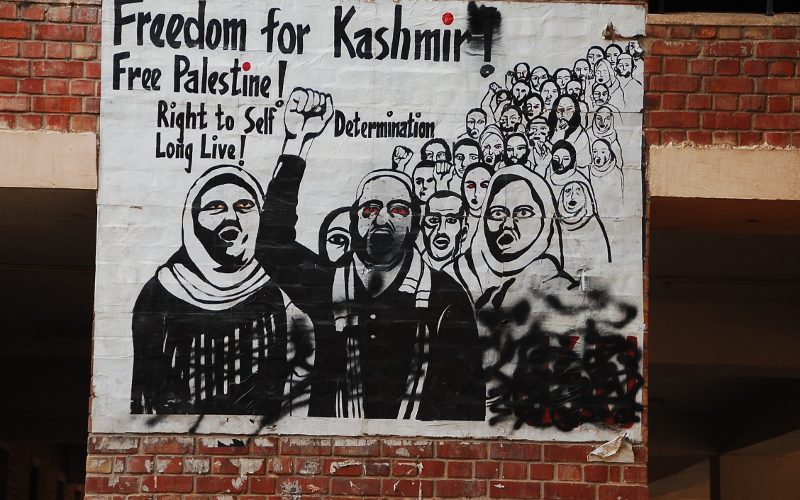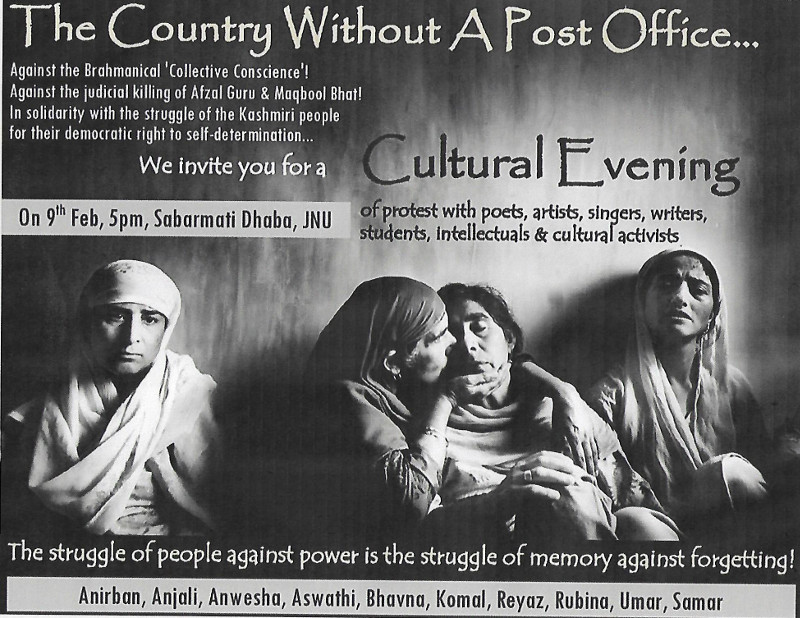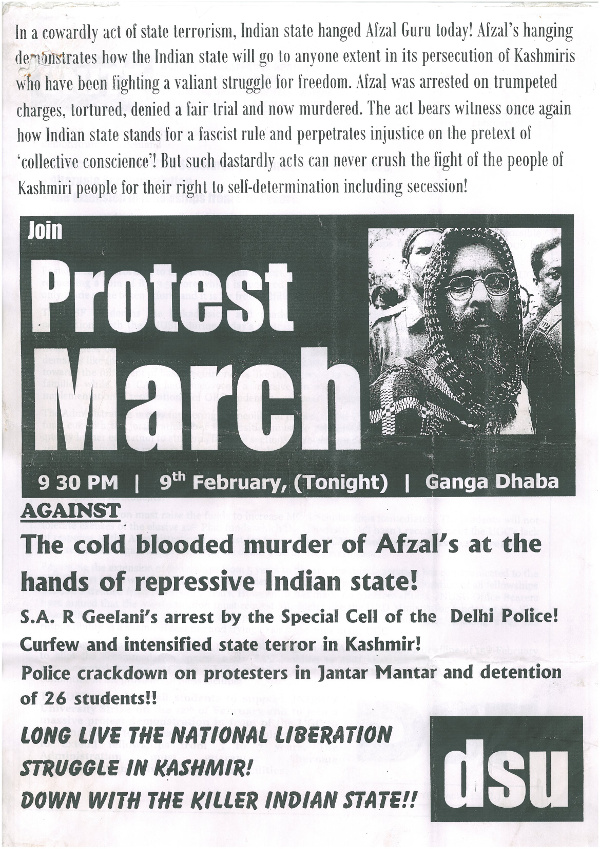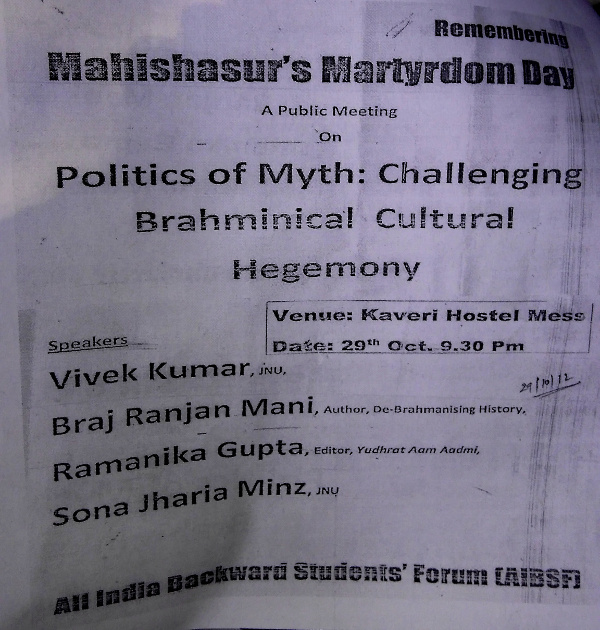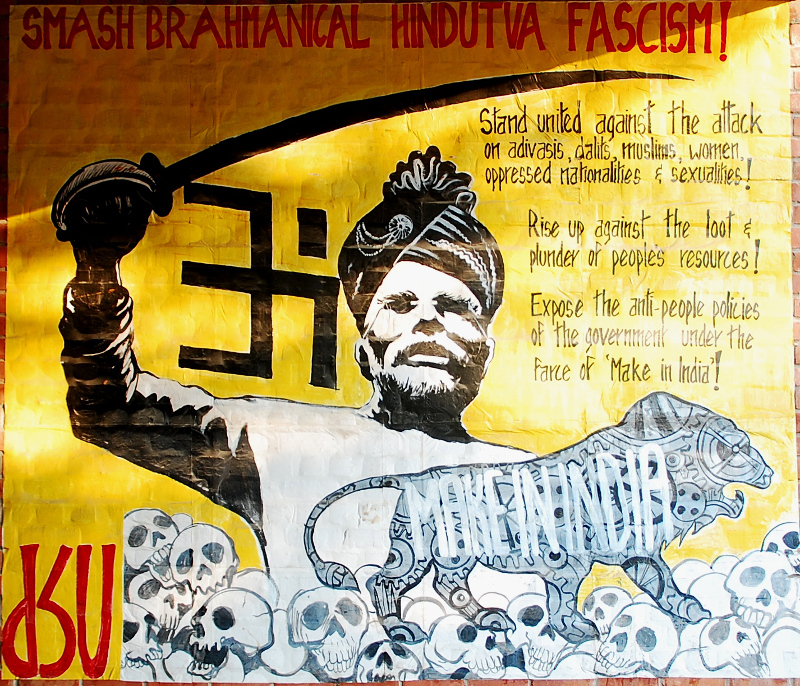Let us Revisit 9 February 2016
Dear readers, let us revisit that day a little more than two years ago. On 9 February 2016, a group of students organized an event in Jawaharlal Nehru University. This purportedly ‘cultural evening’ received a fair attendance. Not just JNU students, I have been told that the fete attracted attendees from Jamia Milia Islamia and Aligarh Muslim University as well. It had been organized to grieve the ‘judicial killing’ of Afzal Guru and Maqbool Bhatt and condemn the ‘Brahmanical collective conscience’ that was responsible for it (see poster below). Guru had been hanged in 2013 after the Supreme Court found him guilty of involvement in the attack perpetrated on the parliament of India (in 2002). Bhatt had received the capital punishment in 1984. He was a member of the Jammu and Kashmir Liberation Front and was sent to the gallows for the murder of a police inspector.
As the evening progressed, the ‘culture enthusiasts’ gathered at the venue (mentioned on the poster) took to raising slogans – they were particularly provocative. One of the slogans shouted was,“Tum kitne Afzal maroge?Har ghar se Afzal niklega!” (How many Afzals will you kill? Every household will produce one!). Another was, “Afzal hum sharminda hain, tere qatil zinda hain!” (Afzal, we are ashamed, your killers still live!). These chants were followed by a full throated, collective shouting of “Bharat tere tukde honge! Insha Allah, insha Allah” (India, you will go to pieces! Allah willing!). By the time the security guards intervened and the police and media arrived on campus (some students had tipped them off), the sloganeers had moved on to “Kashmir mange azadi! Kerala mange azadi!” (Kashmir wants freedom! Kerala wants freedom!). On that tumultuous evening in JNU, the Indian nation-state was symbolically dismantled through slogans. You must wonder what is it about that university that allowed for this to happen. Yes, the event had drawn a number of Islamists; the slogans that were raised obviously indicate their participation. But not all of those who took part in it were radicalized adherents of a certain religion. They were regular JNU students. What made them join their voices with the Islamists who wanted an Afzal to emerge from every dwelling and India to break into pieces? Were they not aware of the terrible insanity of what they were doing?
“What! You Watch the Republic Day Parade?”
Yes, I do. I have loved watching the Republic Day parade on television since I was a small boy in school. One day, I wish to be on Rajpath to witness it. But in JNU, where I spent several years as a student, it was a major social gaffe to declare that aloud before anyone – whether teacher or student. A few times I did, the other person gave me a patronizing smile and shot off, “What! You watch the Republic Day parade?” In JNU that is a loaded condemnation. Unpacked, the exclamation implies the following – ‘So you are a lover of the decadent, oppressive Indian state? What shame! Fie upon you!’ You see, expressing any affection for this vast and beautiful country that we inhabit is a supremely backward thing in JNU. So, the years I was there, I watched the 26 January parade sheepishly, even thievishly. At ten in the morning, I would tiptoe into the recreation room of my hostel, where the television was kept, with a toothbrush in hand. If a fellow student came by, I could pretend that I had strayed there while brushing my teeth and will be gone soon. When you are very young, the fear of ridicule from your peers can make you behave quite abnormally. If no one came by, I enjoyed all the pageantry in the company of Makhanji, the head-cook of the hostel, and his half a dozen odd assistants. We cheered the marching regiments with gusto and waited for the floats of our respective states to appear on Rajpath. But, I must confess, every year there were moments when the toothbrush weighed heavy in my hand and I wished the playacting was not required. It could not be helped though, since, as you must have figured by now, JNU has an uneasy relationship with the Indian nation-state. That is why, all that occurred on the evening of 9 February 2016 on that campus was nothing unusual. Let me tell you that till 2016 the commemoration of Afzal Guru’s ‘judicial killing’ was an annual event in JNU. Yes, really! It is only that on that fateful evening two years ago things got a little out of hand, even by JNU standards. The unthinkable is regular business there since a lot of JNU faculty and students, especially those in its School of Social Sciences, are somewhat ill-disposed towards this country of ours. This is because of certain theoretical prejudices that they carry in their heads. I shall try to provide a brief summary of them below.
The Democratic Students’ Union (DSU) is a militant left group active in JNU. Three or four years ago, they took out a protest march on the campus against Afzal Guru’s “cold blooded murder.” Till 2016, such events were de rigueur in JNU. Please note that the DSU calls the Indian state “fascist” and “repressive” and condemns the “persecution of Kashmiris who have been fighting a valiant struggle for freedom.”
The Indian Nation-State is a Bourgeois Fraud
Now that little Tripura has voted out the communists, there are two places remaining in the country where they still thrive. The first is the state of Kerala; the second is the eleven-hundred acre campus of JNU. Three parties of the Left, Communist Party of India, Communist Party of India (Marxist) and Communist Party of India (Marxist-Leninist), have their students’ wings active there. These are, respectively, All India Students’ Federation (AISF), Students’ Federation of India (SFI) and All India Students’ Association (AISA). All three have substantial followings in JNU. SFI and AISA especially, along with a fringe left group called Democratic Students’ Federation (DSF), currently dominate the JNU students’ union. A number of the JNU teachers too are openly sympathetic to one or another of these organizations. Occasionally, these teachers even address the meetings that they call.
All the above organizations, and the faculty who sympathize with them, tend to disapprove of any overt displays of Indian nationalism. It could be something as innocuous as people celebrating a victory of the Indian cricket team. When India defeated Pakistan in the semifinal of the 2011 cricket World Cup, spontaneous revelries had broken out on the campus and a large number of students had taken out a victory march. The next day, AISF, SFI, AISA and the Democratic Students’ Union (DSU) brought out pamphlets denouncing this display of ‘aggressive hyper nationalism’. Indian nationalism is nearly anathema to the communists since, as the historian Shashi Joshi points out, they view all nationalism as a “bourgeois ideology and all representations of national unity…a bourgeois fraud perpetrated on the masses…”[1] Thus, the patriotic pride and joy that the reveling students (and the country at large) had experienced upon the fall of the last Pakistani wicket was a delusion. In proper Marxist language, that was an instance of ‘false consciousness’ taking grip of the masses.
Why do the bourgeoisie – the owners of business and industry, the middle and upper middle class urban professionals – concoct and subject the masses to the ‘false consciousness’ of nationalism? For the communists, the answer is simple – that is in order to divert their attention from their economic miseries. Nationalism helps the bourgeoisie in keeping the masses from politically organizing to attain their actual class interest – an improvement in their economic lot by ending the bourgeois dominance of economy and polity. Thus, in communist thought “any notion of national interest” is “a euphemism for bourgeois interest”.[2] This Communist prejudice can have truly absurd manifestations. For example, the Indian freedom movement was derided by Manabendra Nath Roy, a radical communist activist and theoretician active in the 1920s and 30s, as a “bourgeois-nationalist movement” that does not express “the sentiments and aspirations of the general population.”[3] In Roy’s view, the ‘general population’ was “interested solely in questions of a socio-economic nature.”[4]
Why did the Indian bourgeoisie want the British out of the country? Well, that was because, as another Communist ideologue called Rajani Palme Dutt wrote in his book India To-Day (first published in 1940), their interests were “in conflict with the British bourgeois”.[5] In other words, as long as India remained a colony of Britain, her economy was subject to the interests of British industrialists and businessmen. In such a situation, the Indian bourgeoisie did not have opportunities of proper growth and advancement. That is why they waged the movement for freedom. The Indian bourgeoisie only cynically manipulated the ‘general masses’ with nationalism since they required their support in this enterprise. While manipulating them, the bourgeoisie also kept their revolutionary spirit in check (since it could have been directed against them). Thus, in communist mythology, the Indian freedom movement was a bourgeois fraud played upon the masses. That is why the Indian Left views its outcome, the Indian nation-state too, as some sort of a bourgeois fraud. Its student foot soldiers active in JNU tacitly share this prejudice. Some among them are ‘Leninists’ (AISA), and they do not see India as a nation-state at all. For them, our country is a collection of distinct ‘nationalities’. This position is a conscious mimicry of their patron saint, Vladimir Lenin’s, reading of pre-revolutionary Russia. Since Lenin saw Tsarist Russia as a conglomerate of nationalities, our student revolutionaries must adopt the same point of view towards their own country. Just as they do not concede the possibility of a genuine Indian nationalism, they do not seem to recognize the existence of anything like an Indian civilization to which all Indians, despite the diversity of their manners and customs, might belong. Hence, they have no trouble chanting “Kashmir mange azadi! Kerala mange azadi.”
The Indian Nation-State is ‘Brahmanical’ and‘Patriarchal’
Some years ago, certain JNU students decided to contest a perceived ‘Brahmanical cultural hegemony’ prevalent in our country by celebrating Vijayadashami as ‘Mahishasur’s martyrdom day’ and organizing a public meeting. Mahishasura, they claimed, was a great non-Aryan hero who has been vilified by the evil Brahmans.
Along with the textual Marxists (those who derive their ideas from Marxist literature, the lot I describe above), JNU harbors a large number of ‘cultural Marxists’, both teachers and pupils. ‘Cultural Marxists’ are people who construct ever new oppressor-oppressed binaries by tracing what they perceive to be the ideological premises of cultural production or social and political organization; they also politicize identities and promote the culture of victimhood. Their verdict is that the Indian nation-state is ‘Brahmanical’ and ‘patriarchal’. The verdict’s basis is the assumption that the Indian nation-state is ideologically rooted in multiple ‘evils’ of the Hindu social order (mind you, the ‘cultural Marxists’ do not see anything good in Hinduism at all). One of the many sins of Hinduism, in the eyes of this lot, is ‘Brahmanism’ – the social primacy accorded to the Brahman caste. They see it tingeing the Indian nation-state to the extent that it is, in their eyes, ‘Brahmanical’ in character. Differently put, what the JNU ‘cultural Marxists’ argue is that the Indian nation-state is instinctively discriminatory towards anyone not a Brahman, or, at least, an upper-caste Hindu of some sort. The students who organized the 9 February 2016 event were fully convinced by this idea. That is why they held a ‘Brahmanical collective conscience’ responsible for the ‘judicial murder’ of Guru and Bhatt. Of course, it does not matter to the JNU ‘cultural Marxists’ that the Indian constitution was drafted by a Dalit, the current President of the Indian Republic is a Dalit as well, its Prime Minister comes from an OBC community and no political party in the country bothers to court the Brahman vote (that is a complete unthinkable). You see, ‘cultural Marxist’ standpoints are generally quite inimical to logic and reason. By the way, do not assume that the JNU ‘cultural Marxists’ stand identifiably apart from the textual Marxists. Be it AISF, SFI, AISA or DSU, all take their ‘cultural Marxist’ propaganda pretty seriously. They serve as cat’s paw for the ‘cultural Marxists’.
How has the Indian nation-state come to be ‘Brahmanical’ in character? The explanation is provided by yet another conspiracy theory pertaining to the Indian freedom movement. It has been most eloquently developed by G. Aloysius. Certain of his ideas enjoy great traction with the JNU ‘cultural Marxist’ community, many members of which are active as Social Justice Warriors (SJWs) in the outside world. According to Mr. Aloysius, the British, after acquiring imperialist control of India, recruited the upper castes “into a unified bureaucracy for administration.” That is, they found among the Indian upper castes the lower level officials required to run the colonial administration. Naturally, a lot of them are likely to have been Brahmans as they had an old heritage of literacy. Thus, Mr. Aloysius claims, the erstwhile religious and cultural dominance of the upper castes was turned into “state power” by the British.[6] However, a certain turn of circumstances eventually made the Indian upper castes turn against their British masters. British rule, says Mr. Aloysius, also emboldened many communities earlier oppressed by the upper castes to assert themselves. These were, he points out, the Izhavas and Shanars in South India, the Malis in Maharashtra (under the leadership of Jyotiba Phule), the Chandals in Bengal and the Yadavs in Bihar and U.P. Since these communities wanted to “sabotage oppressive Brahmanism”[7], the Brahmans and the allied upper castes now wanted the British out of India. This is how, Mr. Aloysius argues, the Indian freedom movement was born. It was led by the Brahmans and other upper castes since they were anxious to re-establish control over the people they once oppressed. Naturally, thus, the nation-state that was established after the eviction of the British from India has turned out to be ‘Brahmanical’ in character. Please check your outrage if you are feeling any, there is work to be done yet. Now we must understand how (as per the ‘cultural Marxists’) ‘patriarchy’ is fundamental to Indian nationalism and, by extension, the Indian nation-state.
There is no clear distinction between the textual and ‘cultural Marxists’ in JNU, as these posters demonstrate. You have both the DSU and AISF depicting Narendra Modi as a champion of evil ‘Brahmanism’ or Hinduism. In both posters he presides over a pile of human skulls. In the first, he is inspired by “Brahmanical Hindutva fascism” and wields a sword with the obvious intention to kill. In the second, he is shown as an evil Krishna and appears to be playing with Indian democracy by spinning the parliament building around his index finger. The Bhagwad Gita seems to be inspiring him to establish some sort of a murderous dharma, which is perhaps why there are skulls at his feet.
One must understand that there is a difference between acknowledging that many women suffer violence and oppression in our country (as they do in any other country) and claiming that the Indian nation-state is fundamentally inclined towards the oppression of women. The latter is the standpoint of the JNU ‘cultural Marxists’. Please take a close look at the DSU poster above. You will see that it includes women (along with Adiwasis, Dalits and Muslims) among the victims of the “Brahmanical Hindutva fascism” that supposedly drives the current Prime Minister of India, Mr. Narendra Modi. Why is the Indian nation-state so inimical to women? That is because, it is claimed, Indian nationalism was born out of a patriarchal and conservative reflex among upper caste Hindus – this insinuation is made by certain scholars whose ideas enjoy much popularity is JNU.
Tanika Sarkar, former Professor of History at JNU and a left-leaning feminist, writes in her book Hindu Wife, Hindu Nation that, as India fell under the colonial sway, upper caste Hindus valorized their distinctive domesticity and conjugality (marital norms), since British colonialism could not touch these private aspects of Hindu existence. Further, the Hindu woman was assigned a special role in this domestic and conjugal space since her body “was still pure and unmarked [by colonialism], loyal to the rule of the shastras.”[8] It was not the case with the Hindu male as he had to operate in the outside world to earn a living. In this imagination now, in her words, “the household was the embryonic nation” and “the woman was the true patriotic subject”.[9] The strict conjugal monogamy of the Hindu wife was celebrated, she suggests, for it made the essence of Hindu domesticity in upper caste view and signified the Hindus’ cultural superiority to the colonizing British. Thus, in the disapproving, left-feminist eyes of Prof. Sarkar, a set of conservative, patriarchal, upper caste ideas – they tied Hindu women to oppressive domesticity and monogamy – formed the core of the emerging Indian nationalism in the nineteenth century.
Professor Partha Chatterjee is a political scientist and former Director of the Center for Studies in Social Sciences in Kolkata, he is currently teaching at Columbia University. Earlier known only in the academic circles, he shot to national fame last year when he compared the current Chief of Army Staff, General Bipin Rawat, to the British General Dyer (responsible for the Jalianwala Bagh massacre) in an article he wrote for a very leftwards oriented ‘news and current affairs’ (propaganda?) website. In his book, The Nation and its Fragments, Prof. Chatterjee makes claims that closely approximate Prof. Sarkar’s. According to Prof. Chatterjee, during the days of British rule, early Indian nationalist thought divided the world into two realms – the material and the spiritual, or the outer and the inner. In this dichotomy, colonialism was seen to have subjugated the outer, material world, but the inner, spiritual domain of Indian existence was still free. Women were now viewed as its peculiar embodiments, since they were the custodians and nurturers of households. In this capacity they were also the preservers of the inner, spiritual domain of Indian life, as the household was its manifestation. Thus, Prof. Chatterjee censoriously points out, nationalist thought came to expect of Indian women a slew of things – the virtues of “orderliness, cleanliness, and a personal sense of responsibility, the practical skills of accounting, hygiene, and the ability to run the household according to the new physical and economic conditions set by the outside world”[10] – and increased the domestic burdens upon them. Consequently, the emerging Indian nationalism inflicted on Indian women a “new patriarchy” along with a “new, and yet entirely legitimate subordination.”[11] Thus, we find that both Prof. Sarkar and Prof. Chatterjee accuse Indian nationalism of suffering from a ‘misogynistic conservatism’.
One might argue that the early nationalist thought the two etch was operating within the ancient dharmic ethos of India which view women as the spiritual and cultural nurturers of nations and peoples. Hence, this thought assigned women a crucial nationalist agency within the domestic realm not out of misogyny but due to the peculiar sanctity that Indic belief accords to femininity. But these ideas must be foreign to the two scholars since they apparently are, or choose to be, completely ignorant of the dharmic frame of ethics. Resultantly, the ‘cultural Marxists’ populating JNU, for whom their ideas are staple (they are much discussed in the ‘gender studies’ circles), are ardently convinced that the Indian nation-state too, like the nationalist thought that brought it forth, is (violently) misogynistic and inimical to women – they assume that patriarchy is fundamental to its very nature.
And, then, there is the ‘Anywhere Mindset’
Along with the theoretical prejudices I illustrate above, what makes JNU’s relationship uneasy with the Indian nation-state is the ‘anywhere mindset’ of a lot of its faculty and an articulate, influential minority of its students. What is the ‘anywhere mindset’? In the words of the British journalist and political commentator David Goodhart, it is an attitude which “places a high value on autonomy, mobility and novelty and a much lower value on group identity, tradition and national social contracts (faith, flag and family).”[12] In other words, individuals with the ‘anywhere mindset’ are just that, individuals. They are not culturally or socially rooted; they could easily move, work and live anywhere. However, there is a definite economic and social segment that they can be identified with. In Britain, says Mr. Goodhart, people with the anywhere mindset belong to the “upper quartile of the income and social spectrum.”[13] My observation is that this is true for JNU as well, definitely for its School of Social Sciences – it is the most politicized academic school of JNU where the above described theoretical prejudices are most prevalent. During my days in JNU, SSS had many teachers and students who were the progeny of senior bureaucrats, or well known academics and journalists – their families belonged to the old, entrenched elite and, definitely, the higher income bracket. I guess it still must be the case there. What struck me particularly about this demographic was that most of it could not speak an Indian language with any degree of competence. Apparently, they came from English speaking households. This also explains their ‘anywhere mindset’ and their tendency to censor the rustic hoi polloi who displayed a fondness for watching the Republic Day parade.
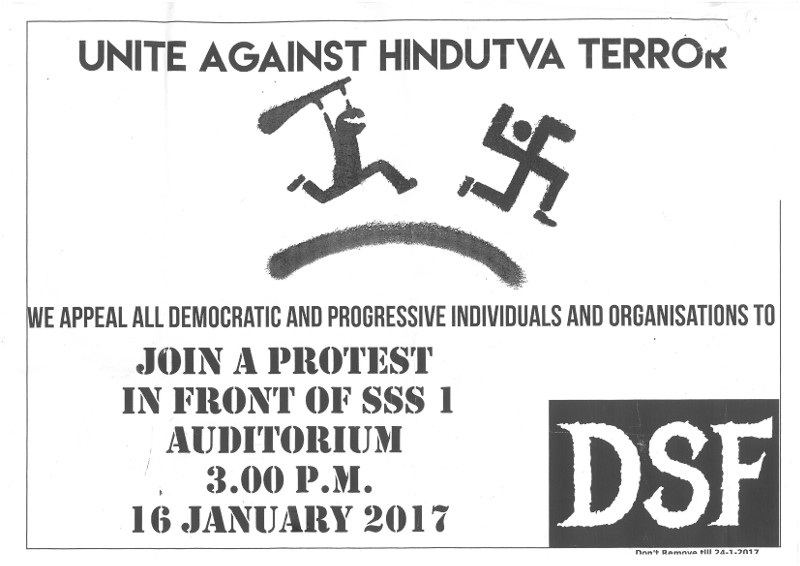 The Democratic Students’ Front (DSF) declares its intention of smashing the Swastika and, with it, ‘Hindutva terror’. Such political language and imagery is informed by the ‘anywhere mindset’ which puts no premium on the emblems of faith and tradition.
The Democratic Students’ Front (DSF) declares its intention of smashing the Swastika and, with it, ‘Hindutva terror’. Such political language and imagery is informed by the ‘anywhere mindset’ which puts no premium on the emblems of faith and tradition.
[1]Struggle for Hegemony in India. The Colonial State, the Left and the National Movement. Volume I: 1920-34, Sage Publications, New Delhi, p.252.
[2]Struggle for Hegemony in India, p.306.
[3]Struggle for Hegemony in India, p.47.
[4]Struggle for Hegemony in India, p.48.
[5]India To-Day, People’s Publishing House, New Delhi, 2008, p.318.
[6]Nationalism without a Nation in India, OUP, New Delhi, 1997, p.49.
[7]Nationalism without a Nation in India, p.107.
[8]Hindu Wife, Hindu Nation. Community Religion and Cultural Nationalism, Permanent Black, New Delhi, 2003, p.43.
[9] Hindu Wife, Hindu Nation, p.43.
[10]The Nation and its Fragments. Colonial and Postcolonial Histories in The Partha Chatterjee Omnibus, OUP, New Delhi, 1999, p.130.
[11] The Nation and its Fragments, p.130.
[12] The Road to Somewhere. The Populist Revolt and the Future of Politics, Hurst and Company, London, 2017, p.5.
[13] The Road to Somewhere, p.24.
Featured Image: A poster on the wall of the School of Social Sciences building in JNU demands freedom for Kashmir.
The images used to illustrate this article have been acquired with the kind assistance of Mr. Saurabh Sharma, research scholar at JNU.
Disclaimer: The opinions expressed within this article are the personal opinions of the author. IndiaFacts does not assume any responsibility or liability for the accuracy, completeness, suitability, or validity of any information in this article.
The author is Assistant Professor of History at O P Jindal Global University

